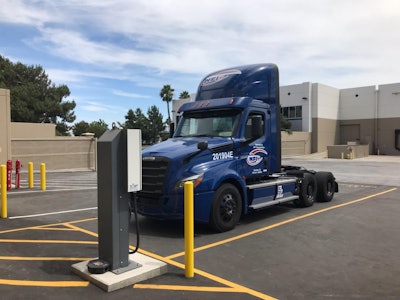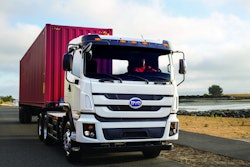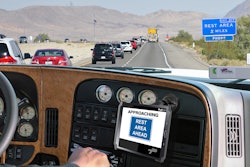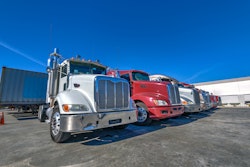NFI has jumped in deep with electric trucks. In addition to 10 eCascadias the carrier is operating 27 Kalmar electric yard tractors. Daimler’s Innovation Fleet supplied the eCascadias which have been busy operating out of NFI’s 15-million square foot warehouse campus in Chino, Calif.
“We just surpassed, probably close to 220,000 miles combined in that fleet,” said Jim O’Leary, vice-president of fleet services for NFI. “Over 1,500 trips to the ports of L.A. and Long Beach done with the electric vehicles. Zero emissions. We’re proud of that. We actually just took, but they’re not in service yet, two of the electric VNRs by Volvo. We are about ready to start running those into the ports of L.A. and Long Beach as well.”
The eCascadias head out to the ports from Chino with empty containers, pick up a load and head back to deliver to NFI’s customers, most of whom are at the Chino campus. It’s a 128-mile round trip on average.
“It can be a quick 115-mile round trip if they don’t have to bounce around all the different terminals at the ports,” O’Leary said. “And it can be as high as 150 miles. We’ve seen that as well.”
 NFI’s top concerns with electric trucks remain with charging. “I’m not worried about 60% reliability on my vehicle right now. I’m worried about 60% reliability on my chargers because those are the types of problems that we’re seeing,” said Jim O’Leary, vice-president of fleet services for NFI.
NFI’s top concerns with electric trucks remain with charging. “I’m not worried about 60% reliability on my vehicle right now. I’m worried about 60% reliability on my chargers because those are the types of problems that we’re seeing,” said Jim O’Leary, vice-president of fleet services for NFI.As far as payload, O’Leary said they’re not seeing diminished loads.
“We have not because we are maxing out of the ports with our current customer base at around 72,000 pounds. We’re not seeing it,” he said. “The same loads that we’ve been picking up from the ports in our diesels are the same loads that we can pick up in the eCascadia.”
Though fleets and their drivers may bristle at the thought of being stuck on the side of the road with a drained battery pack, after 220,000 miles in the trucks, NFI has had no such issues.
“We have not had one issue where we’ve run out of charge or anything like that,” O’Leary said. “We don’t have range anxiety in these vehicles but we’re sticking with what we can do and those trucks are doing one trip and coming back and charging and then a second-trip driver will get to that truck and take it to the port.”
The challenge arises with charging. Once an eCascadia returns to Chino from the port with a load, it has to charge up before it hits the road again. Using a 150-kilowatt charger, it takes 2 ½ to 3 hours before the truck is juiced up for another trip.
“I can get three trips to the port in a diesel in a day,” O’Leary said. “I can only get two with the electric because it needs to charge.”
Like other carriers willing to put zero-emission trucks to work, NFI is hoping for the best technology possible to get the job done.
“If this is going to happen at the scale that everybody is expecting including the State of California, you need better battery technology,” O’Leary said. “You need that reduction in weight so it can handle more applications because there’s only a certain amount of applications in this industry that can handle a truck that goes somewhere between 160 and 200 miles.”













